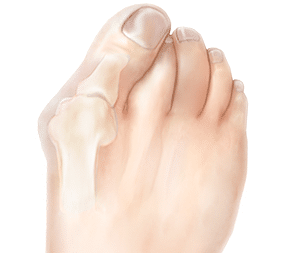
What is a Bunion?
Also known as hallux valgus, A bunion is a bony prominence at the base of the big toe. It causes pain, redness and rubbing against footwear. When this bony bump occurs along the outside of the foot at the joint of the little toe, it’s called a tailor’s bunion. It can change the normal foot shape making it difficult to find shoes that fit correctly.
Even though there is no consensus about the actual cause of bunions occur. The most plausible causes include genetics or family history, arthritis, tight-fitting shoes, amongst others.
Bunion Symptoms and Signs
- Painful lump on foot (bony bump at the base of the big toe)
- Sore and swelling feet
- Lump on the outside side of the foot
- Sore skin over the bony bump
- Pain in the joint of the big toe
- Change in the shape of the foot
- Difficulty fitting shoes
Bunion Treatment
There are a handful of options for bunion treatment out there. Depending on if your bunion is painful or causing issues with your shoewear, it will depend on how you treat this. Surgical options are available when all else fails.
Conservative Treatment:
- Change up your shoes. It’s important to wear comfy, roomy, shoes that provide enough space for your toes.
- Padding and taping or splinting. If you check your local pharmacy you will find over-the-counter, nonmedicated bunion pads. Another option is to ask your doctor to help tape your foot in a normal position. This is a good option to reduce stress and alleviate pain.
- Medications. Acetaminophen (Tylenol, others), ibuprofen (Advil, Motrin) or naproxen sodium (Aleve) can help you control the pain.
- Cortisone injections also help relieve pain.
- Shoe inserts. when you move your feet as we go about our day, sometimes our shoes may rub on our bony protrusion, padded shoe inserts can help distribute pressure evenly and prevent pain from worsening. Over-the-counter arch supports can provide relief for some people; others require prescription orthotic devices.
- Ice. Icing your bunion after you’ve been on your feet too long or if it becomes inflamed can help relieve soreness and inflammation.
Surgical Treatment Options:
Surgical options are available once you are ready to move forward and if conservative options are no longer helping. However, surgery is usually not recommended unless your bunion has become painful.
Surgical Procedures:
There are several procedures you can look into once your are ready for surgery. Those options are:
- Removing the swollen tissue from around your big toe joint
- Straightening your big toe by removing part of the bone
- Realigning the long bone between the back part of your foot and your big toe, to straighten out the abnormal angle in your big toe joint
- Joining the bones of your affected joint permanently
Minimally Invasive Bunion Surgery
We get asked this question often, “What is the difference between minimally invasive surgery and non-invasive procedures?”
When compared to traditional bunion surgery, minimally invasive surgical approach provides:
- Less postoperative pain
- Less recovery time
- Smaller incision means minimal scars
This procedure is only approved to be performed by the top surgeons who are specially trained in minimally invasive bunion removal.
Call us today to schedule a consultation with the top bunion specialist, 888-409-8006 or visit us online to schedule a consultation.
